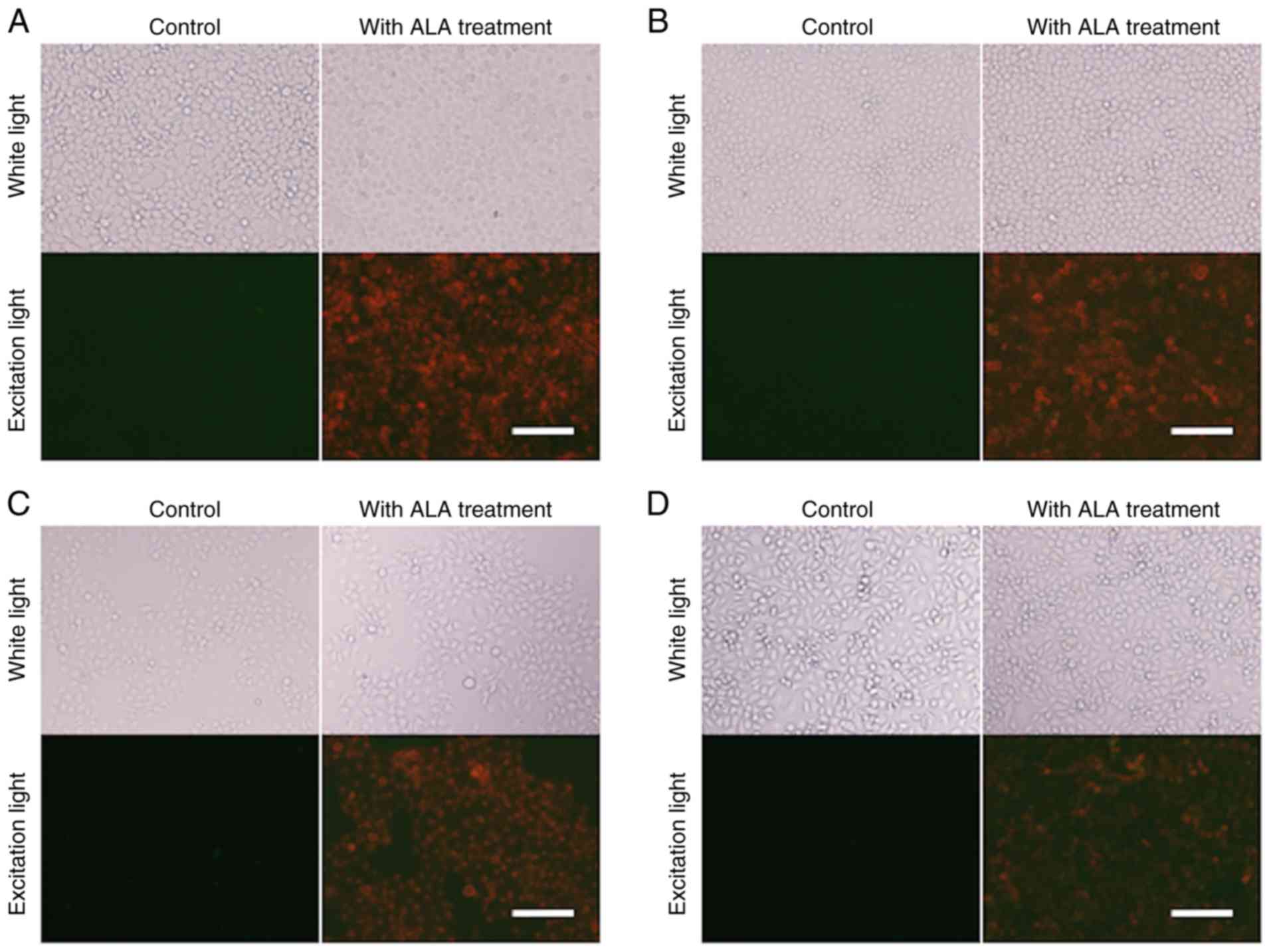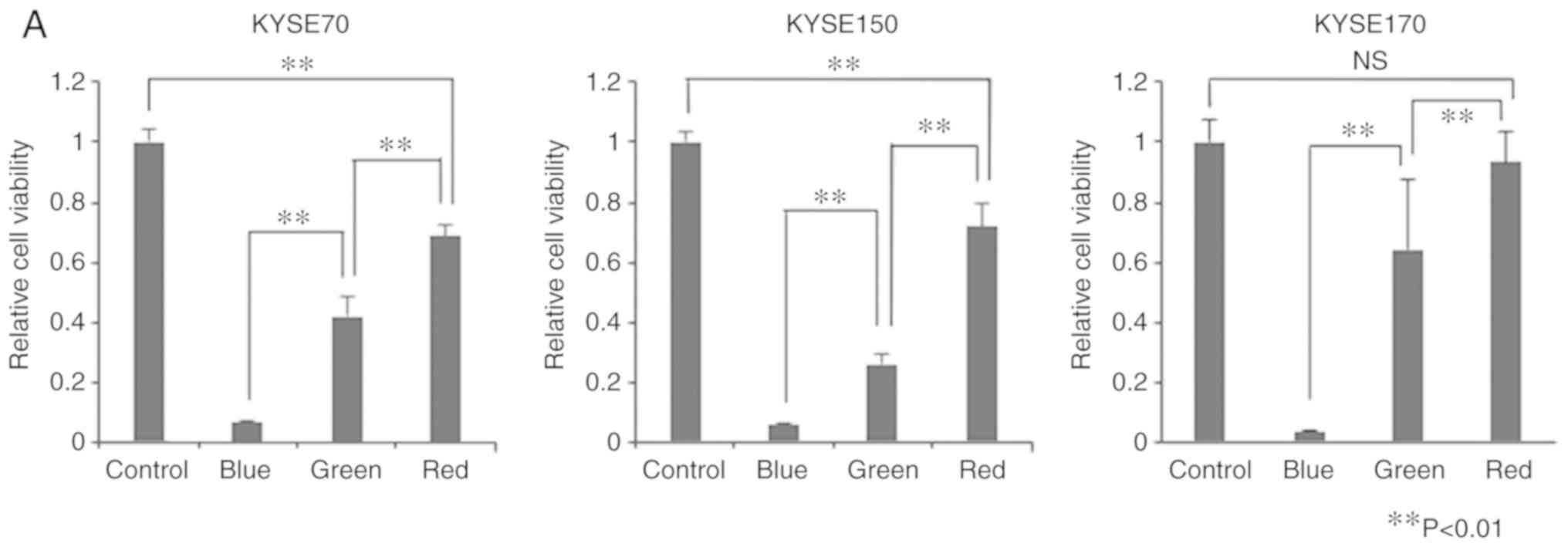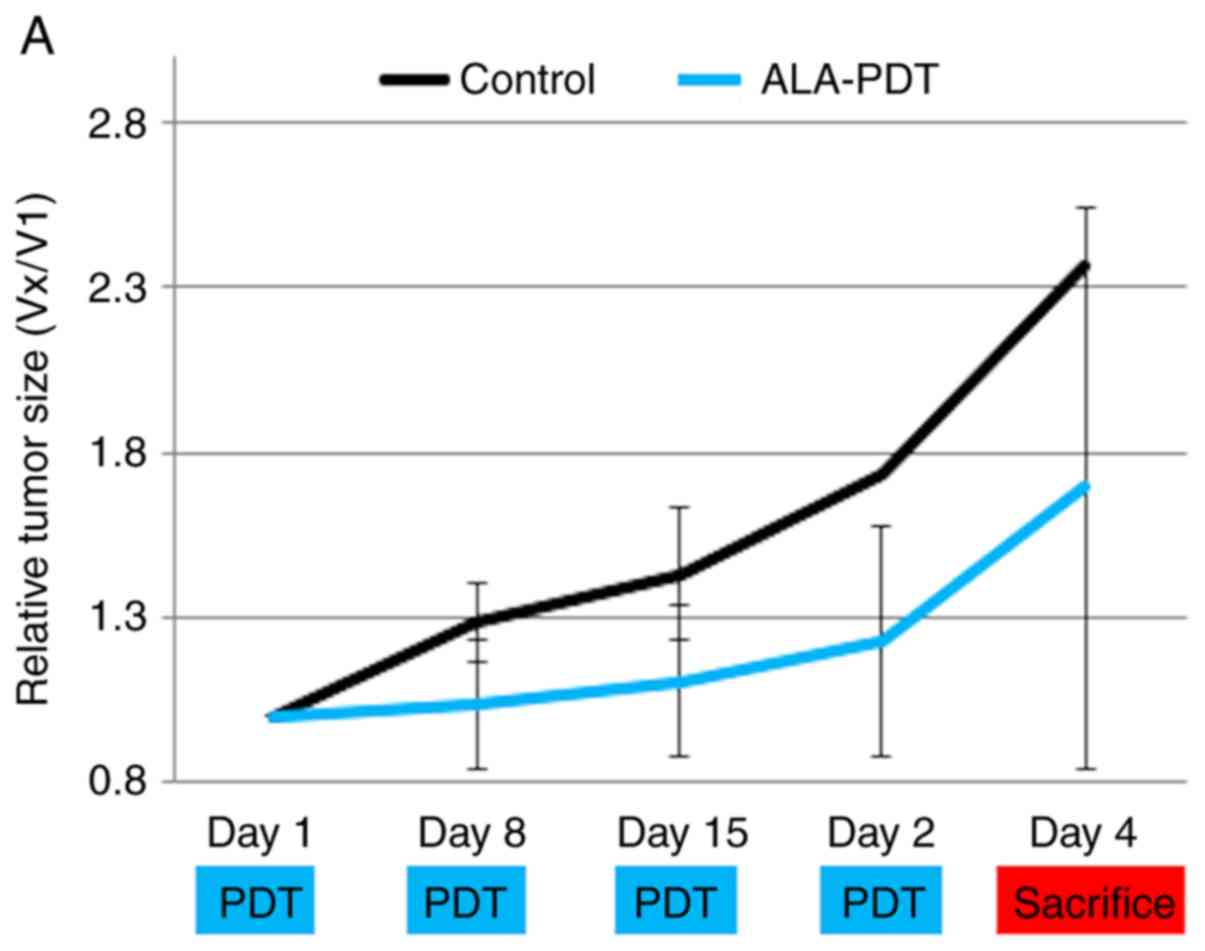|
1
|
Tachimori Y, Ozawa S, Numasaki H, Ishihara
R, Musubara H, Muro K, Oyama T, Toh Y, Udagawa H9 and Uno T;
Registration Committee for Esophageal Cancer of the Japan
Esophageal Society, : Comprehensive Registry of Esophageal Cancer
in Japan, 2010. Eshophagus. 14:189–214. 2017. View Article : Google Scholar
|
|
2
|
Cancer Registry and Statistics, . Cancer
Information Service, National Cancer Center. Japan: October
12–2018
|
|
3
|
Dougherty TJ, Kaufman JE, Goldfarb A,
Weishaupt KR, Boyle D and Mittleman A: Photoradiation therapy for
the treatment of malignant tumors. Cancer Res. 38:2628–2635.
1978.PubMed/NCBI
|
|
4
|
Hayata Y, Kato H, Konaka C, Ono J and
Takizawa N: Hematoporphyrin derivative and laser photoradiation in
the treatment of lung cancer. Chest. 81:269–277. 1982. View Article : Google Scholar : PubMed/NCBI
|
|
5
|
Mimura S, Ichii M and Okuda S:
Photodynamic Therapy for Early Gastric Cancer Using Excimer Dye
Laser. Elsevier Science Publication. (Amsterdam). 272–276.
1992.
|
|
6
|
Lu YG, Wang YY, Yang YD, Zhang XC, Gao Y,
Yang Y, Zhang JB and Li GL: Efficacy of topical ALA-PDT combined
with excision in the treatment of skin malignant tumor. Photodiagn
Photodyn Ther. 11:122–126. 2014. View Article : Google Scholar
|
|
7
|
Mlkvy P, Messmann H, Debinski H, Regula J,
Conio M, MacRobert A, Spigelman A, Phillips R and Bown SG:
Photodynamic therapy for polyps in familial adenomatous polyposis -
a pilot study. Eur J Cancer. 31A:1160–1165. 1995.PubMed/NCBI
|
|
8
|
Kübler A, Haase T, Rheinwald M, Barth T
and Mühling J: Treatment of oral leukoplakia by topical application
of 5-aminolevulinic acid. Int J Oral Maxillofac Surg. 27:466–469.
1998. View Article : Google Scholar : PubMed/NCBI
|
|
9
|
Loh CS, Bliss P, Bown SG and Krasner N:
Photodynamic therapy for villous adenomas of the colon and rectum.
Endoscopy. 26:243–246. 1994. View Article : Google Scholar : PubMed/NCBI
|
|
10
|
Smolka J, Mateasik A, Cunderlikova B,
Sanislo L and Mlkvy P: In vivo fluorescence diagnostics and
photodynamic therapy of gastrointestinal superficial polyps with
aminolevulinic acid. A clinical and spectroscopic study. Neoplasma.
53:418–423. 2006.PubMed/NCBI
|
|
11
|
Gomer CJ, Rucker N, Ferrario A and Wong S:
Properties and applications of photodynamic therapy. Radiat Res.
120:1–18. 1989. View
Article : Google Scholar : PubMed/NCBI
|
|
12
|
Dougherty TJ, Gomer CJ, Henderson BW, Jori
G, Kessel D, Korbelik M, Moan J and Peng Q: Photodynamic therapy. J
Natl Cancer Inst. 90:889–905. 1998. View Article : Google Scholar : PubMed/NCBI
|
|
13
|
Dolmans DE, Fukumura D and Jain RK:
Photodynamic therapy for cancer. Nat Rev Cancer. 3:380–387. 2003.
View Article : Google Scholar : PubMed/NCBI
|
|
14
|
Yano T, Muto M, Minashi K, Onozawa M,
Nihei K, Ishikura S, Kaneko K and Ohtsu A: Long-term results of
salvage photodynamic therapy for patients with local failure after
chemoradiotherapy for esophageal squamous cell carcinoma.
Endoscopy. 43:657–663. 2011. View Article : Google Scholar : PubMed/NCBI
|
|
15
|
Tsai JC, Wu CL, Chien HF and Chen CT:
Reorganization of cytoskeleton induced by 5-aminolevulinic
acid-mediated photodynamic therapy and its correlation with
mitochondrial dysfunction. Lasers Surg Med. 36:398–408. 2005.
View Article : Google Scholar : PubMed/NCBI
|
|
16
|
Malik Z and Lugaci H: Destruction of
erythroleukaemic cells by photoactivation of endogenous porphyrins.
Br J Cancer. 56:589–595. 1987. View Article : Google Scholar : PubMed/NCBI
|
|
17
|
Kennedy JC, Pottier RH and Pross DC:
Photodynamic therapy with endogenous protoporphyrin IX: Basic
principles and present clinical experience. J Photochem Photobiol
B. 6:143–148. 1990. View Article : Google Scholar : PubMed/NCBI
|
|
18
|
Peng Q, Moan J, Warloe T, Nesland JM and
Rimington C: Distribution and photosensitizing efficiency of
porphyrins induced by application of exogenous 5-aminolevulinic
acid in mice bearing mammary carcinoma. Int J Cancer. 52:433–443.
1992. View Article : Google Scholar : PubMed/NCBI
|
|
19
|
Almeida RD, Manadas BJ, Carvalho AP and
Duarte CB: Intracellular signaling mechanisms in photodynamic
therapy. Biochim Biophys Acta. 1704:59–86. 2004.PubMed/NCBI
|
|
20
|
Wachowska M, Muchowicz A, Firczuk M,
Gabrysiak M, Winiarska M, Wańczyk M, Bojarczuk K and Golab J:
Aminolevulinic acid (ALA) as a prodrug in photodynamic therapy of
cancer. Molecules. 16:4140–4164. 2011. View Article : Google Scholar
|
|
21
|
Vegter S and Tolley K: A network
meta-analysis of the relative efficacy of treatments for actinic
keratosis of the face or scalp in Europe. PLoS One. 9:e968292014.
View Article : Google Scholar : PubMed/NCBI
|
|
22
|
Fargnoli MC and Peris K: Photodynamic
therapy for basal cell carcinoma. Future Oncol. 11:2991–2996. 2015.
View Article : Google Scholar : PubMed/NCBI
|
|
23
|
Wong TW, Sheu HM, Lee JY and Fletcher RJ:
Photodynamic therapy for Bowen's disease (squamous cell carcinoma
in situ) of the digit. Dermatol Surg. 27:452–456. 2001. View Article : Google Scholar : PubMed/NCBI
|
|
24
|
Hatakeyama T, Murayama Y, Komatsu S,
Shiozaki A, Kuriu Y, Ikoma H, Nakanishi M, Ichikawa D, Fujiwara H,
Okamoto K, et al: Efficacy of 5-aminolevulinic acid-mediated
photodynamic therapy using light-emitting diodes in human colon
cancer cells. Oncol Rep. 29:911–916. 2013. View Article : Google Scholar : PubMed/NCBI
|
|
25
|
Hino H, Murayama Y, Nakanishi M, Inoue K,
Nakajima M and Otsuji E: 5-Aminolevulinic acid-mediated
photodynamic therapy using light-emitting diodes of different
wavelengths in a mouse model of peritoneally disseminated gastric
cancer. J Surg Res. 185:119–126. 2013. View Article : Google Scholar : PubMed/NCBI
|
|
26
|
Chen X, Zhao P, Chen F, Li L and Luo R:
Effect and mechanism of 5-aminolevulinic acid-mediated photodynamic
therapy in esophageal cancer. Lasers Med Sci. 26:69–78. 2011.
View Article : Google Scholar : PubMed/NCBI
|
|
27
|
Wakui M, Yokoyama Y, Wang H, Shigeto T,
Futagami M and Mizunuma H: Efficacy of a methyl ester of
5-aminolevulinic acid in photodynamic therapy for ovarian cancers.
J Cancer Res Clin Oncol. 136:1143–1150. 2010. View Article : Google Scholar : PubMed/NCBI
|
|
28
|
Ito T, Shimada Y, Kan T, David S, Cheng Y,
Mori Y, Agarwal R, Paun B, Jin Z, Olaru A, et al: Pituitary
tumor-transforming 1 increases cell motility and promotes lymph
node metastasis in esophageal squamous cell carcinoma. Cancer Res.
68:3214–3224. 2008. View Article : Google Scholar : PubMed/NCBI
|
|
29
|
Mimura S, Ito Y, Nagayo T, Ichii M, Kato
H, Sakai H, Goto K, Noguchi Y, Tanimura H, Nagai Y, et al:
Cooperative clinical trial of photodynamic therapy with photofrin
II and excimer dye laser for early gastric cancer. Lasers Surg Med.
19:168–172. 1996. View Article : Google Scholar : PubMed/NCBI
|
|
30
|
Kato H, Furukawa K, Sato M, Okunaka T,
Kusunoki Y, Kawahara M, Fukuoka M, Miyazawa T, Yana T, Matsui K, et
al: Phase II clinical study of photodynamic therapy using
mono-L-aspartyl chlorin e6 and diode laser for early superficial
squamous cell carcinoma of the lung. Lung Cancer. 42:103–111. 2003.
View Article : Google Scholar : PubMed/NCBI
|
|
31
|
Murayama Y, Harada Y, Imaizumi K, Dai P,
Nakano K, Okamoto K, Otsuji E and Takamatsu T: Precise detection of
lymph node metastases in mouse rectal cancer by using
5-aminolevulinic acid. Int J Cancer. 125:2256–2263. 2009.
View Article : Google Scholar : PubMed/NCBI
|
|
32
|
Nishimura M, Murayama Y, Harada K, Kamada
Y, Morimura R, Ikoma H, Ichikawa D, Fujiwara H, Okamoto K and
Otsuji E: Photodynamic diagnosis of hepatocellular carcinoma using
5-aminolevulinic acid. Anticancer Res. 36:4569–4574. 2016.
View Article : Google Scholar : PubMed/NCBI
|
|
33
|
Ishizuka M, Abe F, Sano Y, Takahashi K,
Inoue K, Nakajima M, Kohda T, Komatsu N, Ogura S and Tanaka T:
Novel development of 5-aminolevurinic acid (ALA) in cancer
diagnoses and therapy. Int Immunopharmacol. 11:358–365. 2011.
View Article : Google Scholar : PubMed/NCBI
|
|
34
|
Qiao L, Mei Z, Yang Z, Li X, Cai H and Liu
W: ALA-PDT inhibits proliferation and promotes apoptosis of SCC
cells through STAT3 signal pathway. Photodiagn Photodyn Ther.
14:66–73. 2016. View Article : Google Scholar
|
|
35
|
Peng Q, Warloe T, Berg K, Moan J,
Kongshaug M, Giercksky KE and Nesland JM: 5-Aminolevulinic
acid-based photodynamic therapy. Clinical research and future
challenges. Cancer. 79:2282–2308. 1997. View Article : Google Scholar : PubMed/NCBI
|
|
36
|
Araki K, Ohno S, Egashira A, Saeki H,
Kawaguchi H and Sugimachi K: Pathologic features of superficial
esophageal squamous cell carcinoma with lymph node and distal
metastasis. Cancer. 94:570–575. 2002. View Article : Google Scholar : PubMed/NCBI
|
|
37
|
Mizuta H, Nishimori I, Kuratani Y,
Higashidani Y, Kohsaki T and Onishi S: Predictive factors for
esophageal stenosis after endoscopic submucosal dissection for
superficial esophageal cancer. Dis Esophagus. 22:626–631. 2009.
View Article : Google Scholar : PubMed/NCBI
|
|
38
|
Dunn JM, Mackenzie GD, Banks MR, Mosse CA,
Haidry R, Green S, Thorpe S, Rodriguez-Justo M, Winstanley A,
Novelli MR, et al: A randomised controlled trial of ALA vs.
Photofrin photodynamic therapy for high-grade dysplasia arising in
Barrett's oesophagus. Lasers Med Sci. 28:707–715. 2013. View Article : Google Scholar : PubMed/NCBI
|
|
39
|
Tammela T, Saaristo A, Holopainen T,
Ylä-Herttuala S, Andersson LC, Virolainen S, Immonen I and Alitalo
K: Photodynamic ablation of lymphatic vessels and intralymphatic
cancer cells prevents metastasis. Sci Transl Med. 3:69ra112011.
View Article : Google Scholar : PubMed/NCBI
|

















